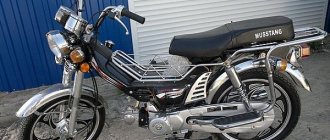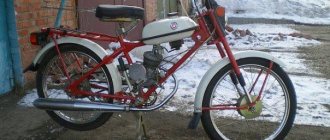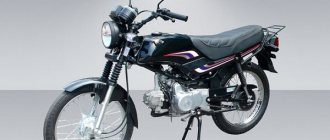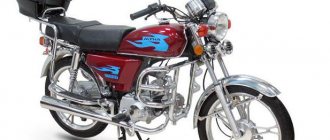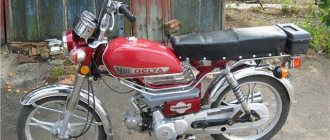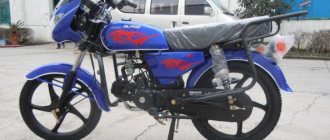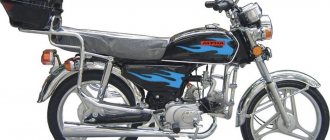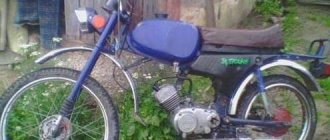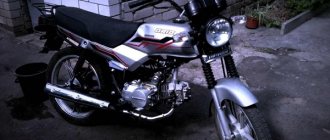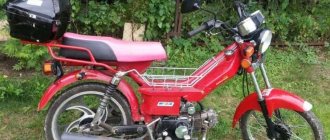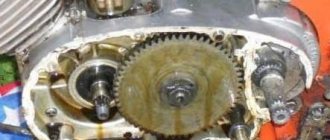Sarkana Zvaigzne, famous in Soviet times, is a Riga motorcycle plant specializing in the production of light mopeds. At that time they were one of the best representatives in their category. The eleventh model replaced the seventh series. The only change was the placement of the fuel tank at the rear on top of the frame, which made it easier to ride downhill. As a power unit, the equipment was equipped with a two-stroke engine with a power of 1.2 horsepower and a volume of forty-five and a half cubic centimeters. With an air-cooled engine, the device reached speeds of up to fifty kilometers per hour.
"Riga-11": technical characteristics
The following are the main parameters of the moped in question:
- weight is 45 kilograms with a maximum possible load of 100 kg;
- length/width/height – 1.97/0.75/1.15 meters;
- wheelbase - 1,200 millimeters;
- the design speed limit is forty kilometers per hour;
- front suspension – telescopic fork with spring shock absorbers;
- a similar rear element is of a rigid type;
- brake unit - drum type with individual drive for each wheel;
- type of frame – spinal welded structure.
"Riga-11" is a moped that was produced with tire sizes of 2.25 by 19 inches.
Features and innovations
"Riga-16" is a moped that has received a large number of innovations and design changes compared to its predecessors. The main thing in this list of innovations was equipping the unit with a kick starter. Before this, the vast majority of motorcycles in this class were produced with pedal drive.
Along with the modified engine start, the designers improved the motor itself, which, thanks to its simplicity and reliability, became practically the standard of its time for users. The Riga-16 moped received two main color variations. An updated rear light, a new trunk shape, a footrest and a brake lever can also be considered the most successful innovations in the development of the model in question.
Power point
Regarding the engine of this vehicle, the following can be noted:
- two-stroke carburetor engine brand D-6;
- its working volume is forty-five cubic centimeters;
- cooling – air with chamber blowing (crank device);
- cylinder size is 38 millimeters;
- compression ratio - 6, with a piston stroke of 4.4 centimeters;
- The engine produces maximum efficiency of 1.2 horsepower at four and a half thousand rpm.
The Soviet moped is equipped with a single-speed gearbox, a double-disc friction clutch, and reaches a torque of up to 29 Nm. The power unit is started by turning the pedals. The ignition unit is a magnetic system. The exhaust exhaust is released through a muffler with partitions for throttling. With a gear ratio of 4.2, the identical chain drive value is 4.1 (the carburetor used is K-34).
More details about the motor and main components
The following are the parameters of the power unit and fuel system:
- engine type – Sh-57, Sh-57 s, Sh-58;
- power - two horsepower, or one and a half kilowatts;
- gearbox - two-stage unit with manual drive;
- clutch block - double-disc version in an oil bath;
- starting the power unit - Sh-57 (pedals), Sh-58 (kick starter);
- fuel – AI-76 gasoline;
- fuel consumption per hundred kilometers – 1.6 liters;
- gear ratio - 3.08.
Studying the characteristics of the Riga-16 moped, it can be noted that it is equipped with a K-35V (K-60) gasoline carburetor, has a contact ignition system with a magneto, and is equipped with a dry air strainer filter.
Peculiarities
"Riga-11" is a moped that had certain improvements compared to previous similar models. The spinal frame consists of a central pipe, to which the clamps of the front fork, motor and some other parts are welded. She became tougher and more resilient. The Soviet moped in question was the first modification equipped with a spine-type frame.
The weakest link in the vehicle's design was the wheels. However, compared to the seventh variation, they received an increased cross-section and did not deform so quickly when driving on uneven roads with potholes. The wheel design itself remains unchanged.
The high steering wheel provides a comfortable driving position and is secured using a pair of clamping elements with nuts. This solution allows you to quickly and reliably change its position. The clutch and front brake levers are equipped with ball-shaped tips that protect against injury when falling.
Riga—11
The spinal-type frame is a strong central tube to which fastening elements for the front fork, engine, rear suspension pipes and other parts are welded. It is distinguished from the previous frame by greater rigidity and durability. Due to the change in the frame, the dimensions of the front fork have changed, although the technical parameters remain the same.
O is the first production model in our country with a backbone frame.
The weakest component in the Riga-7 design were the wheels, the rims of which often failed when driving on roads with uneven surfaces, with stones and potholes. The use of larger section tires on the Riga-11 (2.25-19 instead of 2.00-19 inches) and a reinforced rim will practically ensure long-term operation of the vehicle even in difficult road conditions. The design of the wheel elements remains unchanged.
For a more comfortable driving position, the steering wheel is made high. The fastening method - using two earrings with nuts - allows you to easily and securely fix it in the most suitable position. The clutch and front brake release levers are equipped with rubber ball-shaped tips to prevent injury in the event of a fall.
The design of the saddle has been changed - its box and the thickness of the cushion have been increased. This is done to improve the driver's position and add space for tools. New elements are used in the seat spring fastening, ensuring high manufacturability and reliability of the entire assembly.
The fuel tank located at the rear of the moped together with the trunk forms a fairly large platform on which up to 15 kg of cargo can be transported. The trunk rack prevents the load from sliding and at the same time serves as a handle for moving the moped. The fuel tank volume (4 l) provides a power reserve of up to 200 kilometers. This allows you to make quite long journeys, but on roads remote from gas stations, trips “out into nature”. City dwellers - lovers of such trips and rural residents, will certainly be glad to see a stronger and more durable chain in the motor transmission on the new car.
The engine on Riga-11 is the same as before - D-6. But due to the wide tires, it is shifted to the left from the plane of symmetry of the frame by 7 mm, so that the front and rear final drive sprockets are located in the same plane.
The stand has been made more durable and at the same time more technologically advanced.
Device of other nodes
The saddle design has been improved. His box has become more powerful, and the thickness of the pillow has also increased. This solution made it possible to make the driver’s seat more comfortable and increase the usable space for storing tools. The seat spring is fixed with new elements, ensuring the reliability of the entire assembly.
The fuel tank, together with the trunk, is located at the rear of the moped, forming an impressive platform capable of supporting 15-20 kilograms of cargo. The volume of the fuel tank is four liters. This reserve is enough for about two hundred kilometers.
Thanks to its solid power reserve, Riga-11 is a moped that has become popular both among city residents and in rural areas. The engine remains the same, but the chain is made in a new, stronger and more durable version. Due to the wide tires, the engine was shifted to the right of the symmetrical point of the frame by seven millimeters. This made it possible to position the front and rear sprocket in the same plane.
Riga mopeds model 1976-1977
Since October last year, Riga Moto began producing a new model, instead of the light moped “Riga - 7” - “Riga - 11”, and from the beginning of this year - instead of the moped “Riga - 12” - “Riga - 16”.
Many years of experience in operating previous models, especially in rural areas, revealed the need to improve a number of components and parts. Their modernization has made it possible to significantly improve such important qualities of the machines as reliability, traffic safety and ease of use. At the same time, we managed to give them a more attractive appearance. Let's look at the main design innovations.
Spare parts for mopeds "Riga-11"
Consumable parts for the equipment in question are now quite problematic to find. This applies to original spare parts. It is possible to select or order analogue variations, since they are simple and unpretentious.
During the serial production of the moped, spare parts were available in sufficient quantities. Many users independently rebuilt the engine and other components, trying to improve or repair them. This is quite within the capabilities of a person who has minimal knowledge about the structure of two-wheeled units.
Consumer Reviews
The owners of the equipment in question recall that “Riga-11” is a moped that has become a childhood dream come true. Its simplicity and low price, along with modernization, have become determining factors in the popularity of this transport in cities and villages throughout the country.
Among the advantages of the car are the following:
- more stable wide wheels;
- upgraded saddle;
- strong and practical moped frame.
Now users are more nostalgic for those moments when they could touch the entire mechanism with their own hands and be proud of it. In modern times, this vehicle serves primarily as a museum exhibit or a memorable rarity.
Closest competitors
Among the mopeds of that time, Riga-11 did not have many competitors in its class. Units from the same manufacturer under the indexes 7, 12 and 16 were popular. They differed from the eleventh modification in the location of the gas tank, frame structure, wheel width and some modifications to the engine. Otherwise, the mopeds were almost identical.
Of the other Soviet manufacturers producing competitive equipment, we can mention Verkhovyna. It is worth emphasizing that many spare parts for mopeds were interchangeable, easy to operate, maintain and repair.
Mokik Riga-16: the best of the Soviet past
There are a great variety of two-wheeled vehicles today, but most of them are not produced in our country. But some 20 years ago everything was completely different. The Riga-16 moped is an excellent product of the Soviet motorcycle industry. It was released back in the 80s in the Latvian Soviet Socialist Republic.
The model occupied an intermediate position between motorbikes and motorcycles, and that was its charm. Even the appearance emphasized individuality and clearly showed the evolutionary process of two-wheeled transport. By the way, it was more expensive than a bicycle, but cheaper than a motorcycle - about 180 rubles.
But this is not the main thing. According to the traffic rules, Riga-16 was classified not as a motorcycle, but as a bicycle with all the privileges and concessions that entailed. For example, Riga was not required to be registered with the traffic police, and when traveling on the roads it was not necessary to have a driver’s license. It's all about the motor. It is small in volume - less than 50 cc.
The design of the mokika is extremely simple. The suspension is without any hydraulics, so servicing the Riga-16 did not require high qualifications. The mokik starts with a kick starter. The controls are familiar, like on a motorcycle, only the gears, and there are two of them, are switched on the left handlebar. The first one is needed to start and move uphill. In order not to burn the clutch, when starting, you need to push off the ground with your feet.
Two or more horses are frankly not enough for a mokik. But Riga-16 accelerates to its 50 km/h speed, albeit with difficulty. It is noteworthy that with its own weight of 45 kilograms, the mokik can transport as much as 120 kg, and although it is a single-seater, the boys even managed to give girls rides on it.
Strange thing, a 27-year-old mokik runs not much worse than a modern Japanese scooter! Yes, its control knobs are a little heavier and the gears need to be changed, but you don’t feel any noticeable inferiority when driving. Moreover, there are obvious advantages, the main of which are road stability and good off-road performance. Huge wheels roll easily over any uneven surfaces.
Once upon a time, Riga-16 was wildly popular throughout the Soviet Union, and in the Asian republics it practically replaced horse-drawn transport. And although today the quality of this “rattle” can be safely questioned, its value has not decreased because of this. This thing comes from our childhood, which means it is one of the best in the whole world!
You can get acquainted with other models of motorcycles and automobile classics of the Soviet period on the website: https://drivee.ru.
